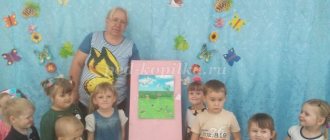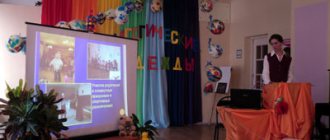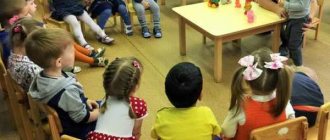Basics of integrated and comprehensive activities in kindergarten
All classes in kindergarten are divided into subject and meta-subject (or inter-subject). And if subject classes are narrowly focused classes, then a meta-subject class means a combination of different conceptual bases. That is, children in such classes develop the ability to consider the same concept from different points of view.
For example, a circle is a geometric figure, a circle is the core of a flower, a circle is a face (we took into account mathematics, the world around us and drawing).
Interdisciplinary classes, in turn, are divided into:
- integrated,
- complex,
- combined.
Combined classes are a combination of different forms of classes or different topics that have no relationship with each other. Example: first, children draw on an arbitrary topic, and then dance to music that has nothing to do with the topic of drawing. This activity is used to develop different skills of the child.
The conceptual boundary between integrated and complex classes is very vague, so many often replace one concept with another, which is not correct. An integrated lesson is a lesson that considers the topic holistically, combining several forms and methods of revealing focus through their mutual penetration into each other.
An integrated lesson is characterized by the development of associative connections between concepts. So, in this lesson, children begin to understand that the concept of “forest” is large, and when we pronounce it, it means a large number of trees, these trees will be different. The forest is a home for birds and animals. At the same time, the forest is a place where mushrooms and berries grow, which we can pick while walking. This means that the forest is a place for walking. In a deciduous forest it is lighter, and in a coniferous forest it is darker. During our walk we will see different forests at different times of the year. In the summer we will be able to listen to the sounds of the forest, and in the winter we will see in the snow traces of animals that live in the forest. This sequence of images, themes and terms forms an intellectual map, which the teacher necessarily draws for the children. At the same time, the concept of forest becomes multifaceted, broad and develops into a full-fledged image of a forest. But this is possible if children are already familiar with the concepts included in the mind map.
The teacher may not show the prepared mind map to the children, but conduct the lesson in such a way that such a map will become its result.
A full-fledged image is formed that allows the child, when the word “forest” is mentioned, to imagine a large number of different options for understanding this word. In this case, the number of activities and their precise change will not matter.
A complex lesson is a lesson that consistently combines different forms and methods of the educational process, united by a common theme. The theme will be present in all successively changing activities, accompanying them and helping to remember and understand the terms. But the main thing is to develop the students’ skills.
Comparing a complex and integrated lesson, it becomes obvious that the first does not go beyond the scope of the topic, and the second, with the help of related topics, reveals and complements the content of this topic
The content of complex and integrated lessons differs in that in an integrated lesson it is very difficult to divide the task into types of activities.
Source:
https://doshkolnik.ru/logopedia/7746-motorika.html
Table: comparison of comprehensive and integrated classes
| Complex | Integrated | |
| Focus | A comprehensive examination of the topic of the lesson with a special emphasis on the development of skills. | Holistic study of the material with the formation of an image. |
| Tasks |
|
|
| Techniques |
|
|
Open integrated and complex lesson for different age groups
To successfully conduct an integrated lesson, it is necessary that children already have a significant conceptual apparatus and different types of activities. At the same time, a complex lesson may contain elements of mastering an activity. Thus, the ability to discuss a topic gradually develops from many different activities where discussion is used as an activity. Preparation of a lesson begins with an adequate assessment of the students’ capabilities and the level of their activity skills.
At the age of 1.5 to 3 years, everything is just beginning:
- speech begins to form;
- vocabulary accumulates;
- coordination improves;
- games are becoming more diverse;
- images are formed, etc.
Not all children of the same age perceive the same material in the same way, but over time everyone will achieve a positive result
Children of the first junior group are more focused on integrated activities, and integrated ones are better used as a summary.
At the age of 3 years, the first significant psychological conflict arises - “I myself!” This is a time of self-awareness in society, a difficult period in a child’s life. Children's actions become intentional and varied. Arms and legs begin to obey the way you want - coordination of movements improves. Rhythm and poetry find an emotional response, and fantasies smoothly enter life based on the emerging visual and figurative thinking. In the second junior group, in addition to final integrated classes, 1–2 generalizing integrated classes can be held during the year.
The development of motor skills at the age of 3 years helps to improve a large number of skills, opening up new opportunities for children
With students in the middle group, we can already talk about conducting classes in the understanding that is typical for most adults. At this time, educational areas can be distinguished. For example, the world around us, elementary mathematical concepts, speech development, etc. At the age of 3 to 4 years, children begin to interact more actively with each other, and their own communication environment develops. Emotions appear and are expressed quite strongly. Friendly relationships develop, sympathy and empathy for peers arise. A sea of feelings and emotions sometimes overwhelms a child. At the same time, the baby is able to consciously remember the rules and follow them.
A 4-year-old child is able to correlate his actions and actions with the actions of his peers.
From the age of 4 years, socially significant skills are instilled, such as rules of conduct in certain places, etiquette, etc.
The age of 5–6 years is the time of why-cheek and big people. A lot can already be discussed with these children; they have their own opinions about a lot of things. Attention, memory and thinking are already under the child’s control, and he can consciously learn a poem for an event that is significant to him.
Games become more intense, roles become more meaningful, and children are able to assess the situation and solve the problem.
Age 6-7 years old - almost a schoolboy. The child has access to educational activities, he can control himself. New opportunities for intellectual activity become available to the baby. At this age, the opinions of others not only influence the child’s behavior at a particular moment, but also his actions in similar situations. The range of capabilities and skills is wide, so a small person can successfully master new concepts and entire sets of images. Children take part in theatrical performances with great pleasure.
More information about integrated and comprehensive classes in senior groups can be found in our article - Integrated and comprehensive classes in the senior group of preschool educational institutions.
A child can successfully complete work not only within the conditions set by an adult, but also creatively approach the given task.
Assessing the capabilities of children, we can say that for pupils 4 years old and older, integrated classes are recommended to be carried out in any quantity. The only question is the feasibility of a large number of such activities. It will be more effective to combine different forms of implementation. There can be no age restrictions: both complex and integrated classes can be successfully conducted.
Summary of an open comprehensive lesson in the first junior group “Matryoshka Fun”
Integration of educational areas: cognition, reading fiction, communication, physical education, socialization.Types of children's activities: play, communication, cognitive research, perception of fiction, physical development
Forms of organization: group.
Forms of work: conversation, solving a riddle about a nesting doll, examining the folk toy matryoshka, didactic game on an easel “Arrange the nesting dolls by size”
, putting together a
Matryoshka
, finger game
“Matryoshka”
, physical education
».
Goal: To evoke an emotional response in children and a desire to participate in play activities.
Tasks.
Educational:
Teach how to communicate using speech and play actions, introduce children to the Russian folk toy matryoshka
Strengthen children's knowledge about size
Continue to teach children to understand spoken speech, stimulate the desire to come into contact with others
Learn how to assemble a puzzle consisting of two parts “Matryoshka”
Learn to arrange nesting dolls by size
Educational:
Develop an interest in artistic expression and answer the teacher’s questions.
develop creative thinking, attention, memory
develop children's speech activity with the help of finger exercises
develop gross motor skills with physical education
Educational:
cultivate interest in Russian folk toys, maintain a cheerful, cheerful mood.
Planned results: participates with interest in a conversation about the nesting doll, takes part in physical education
”, takes part in assembling a two-piece puzzle
“Matryoshka”
;
actively participates in finger gymnastics “Matryoshka”
,
Materials: folk toy matryoshka; a set of nesting dolls on magnets, an easel, trays according to the number of children, a Matryoshka
, consisting of two parts according to the number of children.
Organized children's activities
1. Organizational moment.
There is a matryoshka doll covered with a scarf on the table.
Q: Guys, guests came to us today, say hello to them. Children greet guests. Children sit in a semicircle on chairs. The teacher addresses the children
Q: Guys, look on my table there’s something hidden under a handkerchief. Want to know what it is?
D: Yes, we do.
Q: But first, guess the riddle
Hiding from you and me One doll inside another Wearing polka dots on kerchiefs These dolls... (matryoshka dolls)
D: Matryoshka dolls
The teacher lifts the scarf and takes out one nesting doll from the other and places it on the table.
Q: That’s right, this is a matryoshka doll and her friends. Look how many girlfriends she has. How many are there?
D: A lot
Q: Look how beautiful and elegant they are. What kind of nesting dolls are these, big or small?
D: Small
The teacher shows a large matryoshka doll.
Q: Which one is this?
D: Large
Q: Correct. Guys, nesting dolls love to go for walks. They walked and walked and ran away.
The teacher draws the children's attention to an easel covered with a cloth. He removes the fabric, and on it there are matryoshka doll figures on magnets scattered.
Q: Guys, let's help the nesting dolls get together and arrange them from the largest doll to the smallest.
D: Let's
Children one by one approach the easel and arrange the nesting dolls by size.
Q: That's how great you are. Now let's count our nesting dolls.
Finger gymnastics “Matryoshka”
Children perform hand movements in accordance with the text. For the first two lines, we clench and unclench our fingers. On the third, fourth, fifth lines, bend the fingers, starting with the thumb. On the sixth line they clap their hands.
We are the beautiful matryoshka dolls,
Colorful clothes
One - Matryona, two - Milasha Mila - three, four - Masha Margarita - that's five It's not difficult to count us.
Q: Guys, the nesting dolls have prepared a surprise for us. Want to know what they brought?
D: Yes
Q: You will find out when you collect the picture.
Children sit at tables and assemble the Matryoshka . The teacher helps children who find the task difficult.
Q: Tell me, what did you do?
D: Matryoshka
Q: Look how beautiful your nesting dolls turned out. Well done! Now let's show how we can turn into nesting dolls.
Physical education lesson “We are nesting dolls”
Children perform movements in accordance with the text.
We are nesting dolls (pointing at ourselves with both hands)
We are nesting dolls
We are all babies (crouched down, shaking our heads left and right)
We are all babies
We want to dance a little (hands on the belt, making a “spring” )
Let's walk along the path (walking in place)
Oh, our legs are tired (squatted down)
Matryoshka dolls bow to everyone (bow)
B: Clap your hands. You guys were great today, everyone was very attentive, everyone tried their best. Did you enjoy today's lesson? Who came to visit us? Do you want to play with nesting dolls some more? Then say goodbye to our guests, and the nesting dolls will remain with us in the group, and you can play with them.





